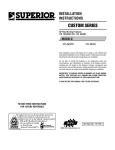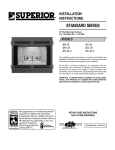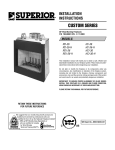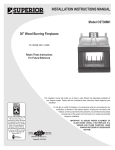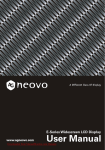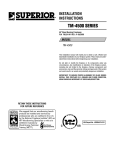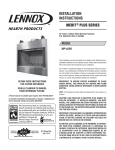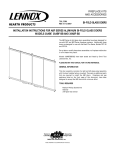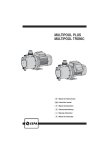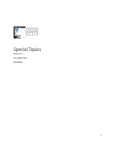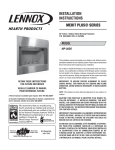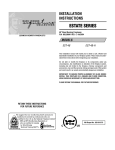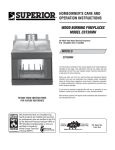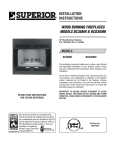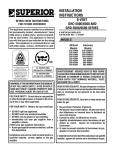Download TOA Electronics CST-38 User's Manual
Transcript
INSTALLATION INSTRUCTIONS CUSTOM SERIES 36" Wood Burning Fireplaces P/N 700,023M REV. C 06/2005 MODELS CST-38 CPF-38 This installation manual will enable you to obtain a safe, efficient and dependable installation of your fireplace system. Please read and understand these instructions before beginning your installation. Do not alter or modify the fireplace or its components under any circumstances. Any modification or alteration of the fireplace system, including but not limited to the fireplace, chimney components and accessories, may void the warranty, listings and approvals of this system and could result in an unsafe and potentially dangerous installation. IMPORTANT! TO ASSURE PROPER ALIGNMENT OF GLASS DOORS: INSTALL THIS FIREPLACE IN A SQUARE AND PLUMB CONDITION, USING SHIMS AS NECESSARY AT SIDES AND/OR BOTTOM. RETAIN THESE INSTRUCTIONS FOR FUTURE REFERENCE OTL Report No. 116-F-20-4 NOTE: DIAGRAMS & ILLUSTRATIONS NOT TO SCALE. 1 TABLE OF CONTENTS Safety Rules .................................... page 2 Tools and Building Supplies ............ page 2 Precautions ..................................... page 3 Introduction ..................................... page 3 Clearances/Height Requirements ..... page 3 Chimney System ............................. page 4 Assembly Outline ............................. page 4 Location of Fireplace ....................... page 4 Assembly Steps ............................... page 5 Preinstallation Notes ........................ page 5 Clearances ....................................... page 5 Installing the Fireplace ..................... page 5 Fireplace Specifications .................. page 7 Framing Specifications .................... page 8 Framing Wall Variations .................. page 9 Installing the Chimney System ........ page 10 Ten Foot Rule Summary .................. page 13 3. These fireplaces must be installed with Security Chimneys FTF8 (8" inside diameter) Chimney System only. These systems are intended for use in any application where a traditional masonry type fireplace would apply. The chimney system must always vent to the outside of the building. 4. To ensure a safe fireplace system and to prevent the build-up of soot and creosote, inspect and clean the fireplace and chimney prior to use and periodically during the heating season. 5. Use solid fuel only. DO NOT use artificial wax based logs, chemical chimney cleaners or flame colorants in your fireplace. Multiple Terminations ...................... page 13 Chimney Component Calculations ... page 13 6. DO NOT use charcoal or coal under any circumstances. Special Offset Instructions ............... page 13 Vertical Elevation Chart ................... page 14 7. NEVER use gasoline, gasoline-type lantern fuel, kerosene, charcoal lighter fluid, or similar liquids to start or “freshen up” a fire in this fireplace. Keep any flammable liquids a safe distance from the fireplace. Offset Elevation Chart ..................... page 15 Offset Calculations ........................... page 16 Installing Offsets .............................. page 16 30° Offset through Floor/Ceiling ...... page 17 Glass Doors ..................................... page 17 Optional Equipment Considerations . page 17 Combustion Air Kits ........................ page 17 Gas Line Connection ........................ page 18 Cold Climate Insulation .................... page 18 Fireplace Finishes ............................ page 18 Mantels and Trim ............................. page 18 Hearth Extensions/Wall Shields ....... page 18 Finish Requirements ........................ page 20 Accessories And Components ......... page 20 IMPORTANT: PLEASE READ AND UNDERSTAND THESE RULES TO FOLLOW FOR SAFETY. 1. Before starting your fireplace installation, read these installation instructions carefully to be sure you understand them completely and in entirety. Failure to follow them could cause a fireplace malfunction resulting in serious injury and/or property damage. 2 2. Always check your local building codes. The installation must comply with all local, regional, state and national codes and regulations. 8. NEVER leave children unattended when there is a fire burning in the fireplace. 9. Always keep flue damper open when heat is present in the fireplace. 10. Before servicing, allow the fireplace to cool. Always shut off any electricity or gas to the fireplace while working on it. This will prevent any possible electrical shock or burns. 11. This fireplace is not intended to heat an entire home or be used as a primary heat source. It is designed to ensure homeowner comfort by providing supplemental heat to the room. 12. Always ensure an that adequate supply of replacement combustion air from the outside of the house is accessible to the fire to support normal combustion. Fireplaces consume large volumes of air during the normal combustion process. In the event the home is tightly sealed with modern energy efficient features, the optional combustion air kit may not provide all the air required to support combustion. NOTE: DIAGRAMS & ILLUSTRATIONS NOT TO SCALE. The manufacturer is not responsible for any smoking or related problems that may result from the lack of adequate combustion air. It is the responsibility of the builder/contractor to ensure that adequate combustion air has been provided for the fireplace. 13. DO NOT use a fireplace insert or any other products not specified herein by the manufacturer for use with this fireplace. All gas log sets must be operated with the damper clamped open. WARNING: THIS FIREPLACE HAS NOT BEEN TESTED WITH AN UNVENTED GAS LOG SET. TO REDUCE RISK OF FIRE OR INJURY, DO NOT INSTALL AN UNVENTED GAS LOG SET INTO THIS FIREPLACE. 14. "Smoke free” operation is not warranteed nor are we responsible for inadequate system draft caused by mechanical systems, general construction conditions, inadequate chimney heights, adverse wind conditions and/or unusual environmental factors or conditions beyond our control. 15. Never, under any circumstances, install a fireplace, chimney component or any accessories, that has visible or suspected physical damage as a result of handling or transportation. These items should be inspected by your distributor or qualified factory representative to ensure safe condition. When in doubt, consult your distributor. 16. For additional safety considerations and complete operating instructions, refer to the Care and Operation Manual provided with the fireplace. TOOLS AND BUILDING SUPPLIES NORMALLY REQUIRED Tools should Include: Phillips screwdriver Hammer Saw and/or sabersaw Level Measuring tape Plumb line Electric drill and bits Pliers Square Building supplies: Framing materials Wall finishing materials Caulking materials (noncombustible) Fireplace surround and hearth extension materials (noncombustible) PRECAUTIONS Note: These fireplace systems are not difficult to install. However, in the interest of safety, it is recommended that the installer be a qualified or certified “tradesman” familiar with commonly accepted fireplace installation and safety techniques as well as prevailing local codes. The most important areas of concern dealing with the installation of factory-built fireplaces are clearances to combustible materials, proper assembly of component parts, height of the chimney system, the proper use of accessories supplied by the manufacturer and the techniques employed in using finishing materials applied to the wall surrounding the fireplace, hearth extensions and wall shields. Each of these topics will be covered in thorough detail throughout this manual. Please give each your special attention as you progress with your installation. INTRODUCTION General Information The CST-38 and CPF-38 Series are radiantheat, two-sided and three-sided fireplaces with required glass doors, that must be ordered separately. A steel grate is included with the CST-38 and CPF-38 to properly position the fire. An outside combustion air kit is available as optional equipment. Note: Illustrations shown reflect “typical” installations with nominal dimensions and are for design and framing reference only. Actual installations may vary due to individual design preferences. However, always maintain minimum clearances to combustible materials and do not violate any specific installation requirements. The CST and CPF systems consists of four “subsystems”: These fireplaces have been tested and listed by Omni Test Labs (Report No. 116-F-20-4) to U.L. standard 127. These units are intended for installation in residential homes and other buildings of conventional construction including commercial, not in mobile homes. CLEARANCES AND HEIGHT REQUIREMENTS These fireplace systems are designed for installation in accordance with the National Fire Protection Standard for chimneys, fireplaces and solid fuel burning appliances; NFPA 211 and in accordance with codes such as the BOCA Basic/National Codes, the Standard Mechanical Code and the Uniform Building Codes. WARNING: FAILURE TO USE MANUFACTURE PROVIDED PARTS, VARIATIONS IN TECHNIQUES AND CONSTRUCTION MATERIALS OR PRACTICES OTHER THAN THOSE DESCRIBED IN THIS MANUAL MAY CREATE A FIRE HAZARD AND VOID THE LIMITED WARRANTY. TYPICAL INSTALLATION Chimney and Termination 1. 2. 3. 4. The Fireplace and Door Assemblies The Chimney and Termination The Optional Combustion Air Kit The Chimney Air Kit (Canada Only) The fireplace may be placed on or near normal construction materials*. The combustion air kit, firestop spacer and roof flashing (not chase flashings) may be placed directly on or against normal construction materials.* The chimney and fireplace outer wrapper require a minimum 2" and 1" air space to combustibles respectively. A combustible mantle may be installed 12" above the opening of the fireplace as per NFPA 211, Section 7-2.3.3. The CPF-38 fireplace opening must be kept a minimum of 8" (203 mm) from an unprotected combustible side wall. The CST-38 fireplace opening must be kept a minimum of 8" (203 mm) from a protected combustible side wall. A perpendicular side wall can not be closer that 7" (178 mm) for both the CPF-38 and CST-38 fireplaces. If there is a continuous perpendicular side wall closer than 18" from the CST-38 fireplace opening, it must be protected with a 40" x 40" x ¹⁄₂" (1016 mm x 1016 mm x 13 mm) wall shield constructed of millboard or a durable noncombustible material with an equal or greater insulating value than k=.84 BTU IN/FT2 HR °F (refer to page 18). As with all chimney installations, avoid overhead obstructions such as trees, power lines, etc. Additionally chimney terminations must meet certain clearance to roof requirements detailed in the paragraph titled Ten-Foot Rule Summary. The fireplace and chimney system must be enclosed when installed in or passing through a living area where combustibles or people may come in contact with it. This is important to prevent possible personal injury or fire hazard. Model CPF-38 Model CST-38 *Construction Materials: • framing materials • particle board • millboard • plywood • paneling • flooring • dry wall • etc. Figure 1 NOTE: DIAGRAMS & ILLUSTRATIONS NOT TO SCALE. 3 For questions, please call your distributor or the manufacturer. Special restrictions apply to the front and facing of the fireplace and nearby walls (See pages 18, 19 and 20 ). CHIMNEY SYSTEM These fireplaces are designed and code listed for use with Security Chimneys FTF8 chimney System only. Always use Security Chimneys FTF8 chimney components with these fireplaces. Do not modify or alter these components as this may cause a potential serious hazard and void the Warranty. Insulate Joists Same As Ceiling Note: Local codes may not require firestopping at the ceiling levels for outside chase installations. However, it is recommended for safety and the reduction of heat loss. The total height of your CST and CPF fireplace systems from the surface the fireplace rests on to the chimney top must not exceed 80' (24.4m) and must also meet minimum system height chart. CTDT Termination Note: NonCombustible Chase Flashing Must Be Used To Cover Chase Opening Minimum System Height Optional Insulation In Outside Walls Of Chase 8' Level Check the operation of the damper. The damper is controlled through the use of a control lever located within the firebox opening at the top center just behind the firebox lintel (Figure 3 ). The control lever snaps into place at the extreme range of motion, up and back in the closed position. When pulled forward and down, the damper is open. Damper Closed Damper Open Lintel Model CST-38 and CPF-38 Security's FTF8 Vertical Installation 15' 0" (4.6 m) One Offset 16' 0" (4.9 m) Two Offsets 25' 0" (7.6 m) Figure 3 LOCATION OF FIREPLACE Carefully select the proper location for heat circulation, aesthetics, chimney obstructions and clearance to side wall(s). With proper preplanning, a slight adjustment of a few inches can save considerable time and expense later during construction and assembly. Chase Enclosure Solid Continuous Surface 4 Check your inventory list to be sure you have all the necessary parts supplied in good usable condition. Check also for any concealed damage. Chimney Height Firestop Figure 2 WARNING: DO NOT PACK OR FILL REQUIRED AIR SPACES WITH INSULATION OR OTHER MATERIAL. NO MATERIAL IS ALLOWED IN THESE AREAS. ASSEMBLY OUTLINE Before You Start Note: Do not insulate the chase cavity with blown or fill type insulation materials. Draft Stops Insulation (Thermal Barrier) WARNING: IF INSULATION IS USED, THE FIREPLACE MUST NOT BE PLACED DIRECTLY AGAINST IT. INSULATION OR VAPOR BARRIERS, IF USED, MUST FIRST BE COVERED WITH GYPSUM BOARD, PLYWOOD, PARTICLE BOARD OR OTHER MATERIAL TO ASSURE INSULATION AND VAPOR BARRIERS REMAIN IN PLACE. Outside Base A chase is a vertical box-like structure constructed to surround the fireplace and chimney. Refer to Figure 2 for a typical chase configuration. A chase should be constructed and insulated just like any outside wall. In a cold climate, we recommend the base of the chase should also be insulated between the solid continuous floor beneath the fireplace and the chase bottom. Chase insulation in a cold climate installation is not required for safety. NOTE: DIAGRAMS & ILLUSTRATIONS NOT TO SCALE. Figure 4 Carefully consider the position of the fireplace opening with respect to the location of adjacent or nearby stairwells, bath or kitchen exhaust fans and/or return air registers for forced air furnaces/air conditioners that could cause a smoking fireplace condition if the house is tightly insulated. This system is intended to be installed in residential homes and buildings of conventional construction, not in mobile homes. When locating the fireplace, consideration must be given to combustibles and final finishing. For an example of this, see Figure 5 and confine the final location of combustible finish materials to the "Safe Zone". DO NOT permanently place furniture or other items such as decorative pillows within 60" of the fireplace front face. Black Portion Of Frame Not To Be Covered With Combustible Materials Wall Covering 12” 6. Install both “All-GlassTM” door assemblies. CLEARANCES 7. Complete finish wall material, surround and hearth extension to your individual taste. Minimum clearance to combustibles for the appliance is as follows: sides and back - 1" (25 mm), floor - 0" (0 mm), adjacent wall - 12" (305 mm), ceiling - 37 ¹⁄₂" (953 mm). Study the three dimensional illustration (Figure 1 ) to get a general idea of each element of your fireplace system. PRE-INSTALLATION NOTES The fireplace may be installed directly on a combustible floor or raised on a platform of an appropriate height. Do not place fireplace on carpeting, vinyl or other soft floor coverings. It may, however, be placed on flat wood, plywood, particle board or other hard surfaces. Be sure fireplace rests on a solid continuous floor or platform with appropriate framing for support and so that no cold air can enter the room from under the fireplace. The fireplace may be positioned and then the framing built around it, or the framing may be constructed and the fireplace positioned into the opening. INSTALLING THE FIREPLACE Step 1. Slide the fireplace into prepared framing or position fireplace in its final position and frame later. The fireplace may not be recessed into a combustible floor. Maintain the floor to hearth clearance established by the fireplace lower front face. Step 2. Insert the provided metal safety strips, beneath the fireplace as illustrated (Figures 6, 7 and 8 ). The safety strips should overlap ¹⁄₂" for continual coverage of the floor. Note: Safety strips are not required when fireplace rests on a noncombustible surface. Usually, no special floor support is needed for the fireplace, however, to be certain: 45° 1” Door Opening 12” Safe Zone Figure 5 ASSEMBLY STEPS Note: The following steps represent the normal sequence of installation. Each installation is unique, however, and might require a different sequence. 1. Position firebox prior to framing or into prepared framing. 2. Install the chimney air kit (Canada only) 3. Install the chimney system. 1. Estimate the total weight of the fireplace system including chimney and surround materials such as brick, stone, etc., to be installed. Shipping weights for the fireplace may be found on page 18. 2. Measure the square footage of the floor space to be occupied by the system, surrounds and hearth extensions. Hearth Extension Metal Safety Strips Floor Floor Figure 6 3. Note the floor construction, i.e. 2 x 6’s, 2 x 8’s or 2 x 10’s, single or double joists, type and thickness of floor boards. 4. Use this information and consult your local building code to determine if you need additional support. Hearth Extension CAUTION: DO NOT BLOCK THE HEAT-CIRCULATING AIR INLET AND OUTLET PORTS ON CIRCULATING MODELS. DOING SO MAY RESULT IN A POTENTIAL FIRE HAZARD. 4. Install optional outside combustion air kit. 5. Plumb gas line if a decorative gas appliance will be used. (Gas connections should only be performed by an experienced, licensed/certified tradesman). Hearth Extension If you plan to raise the fireplace and hearth extension, build the platform assembly then position fireplace and hearth extension on top. Secure the platform to the floor to prevent possible shifting. NOTE: DIAGRAMS & ILLUSTRATIONS NOT TO SCALE. Hearth Extension Metal Safety Strips Platform Floor Figure 7 Note: Install the hearth extension only as illustrated. 5 If the appliance is to be elevated above floor level, a solid continuous platform must be constructed. Platform The header may rest on the top metal spacers, but must not be notched to fit around them. Consult all local codes. * Metal Safety Strips No Combustible Materials in Shaded Areas * 2" Min. (51 mm) * * 2" Min. (51 mm) Figure 8 Figure 10 * * Figure 13 Metal Safety Strips * * * 2" Min. * 2" Min. Figure 9 The safety strips should extend in front and sides of the fireplace opening 2" (51 mm) . In the event a wooden support is used to elevate the fireplace above the floor, a “Z” type safety strip should be fabricated and used to protect the front surface of the wood support as well as the floor beneath the hearth extension (see Figures 8, 9, 10, and 11 ). The safety strips should be tacked down to prevent possible movement. (51 mm) * Special “Z” Metal Safety Strips Figure 11 IMPORTANT: UNDER NO CIRCUMSTANCES CAN THE FIREPLACE TOP SPACERS (FIGURE 12 ) BE REMOVED OR MODIFIED, NOR MAY YOU NOTCH THE HEADER TO FIT AROUND OR BE INSTALLED LOWER THAN THE SPACERS. THE HEADER MAY BE IN DIRECT CONTACT WITH THE TOP SPACERS BUT MAY NOT BE SUPPORTED BY THEM. Figure 14 Note: The “Z” type safety strip is not supplied. 4 x 6 Header Step 3. Refer to fireplace drawings and specifications on pages 7 and 8 for framing dimensions and details. False header may be positioned directly on top of the fireplace spacers (see Figures 12, 13 and 14 ). 2 x 4 False Header Spacer Figure 12 6 No Combustible Materials in Shaded Areas (51 mm) NOTE: DIAGRAMS & ILLUSTRATIONS NOT TO SCALE. FIREPLACE SPECIFICATIONS 12 ¹⁄₂" (318 mm) 10 ¹⁄₂" (267 mm) 5 ¹⁄₄" (133 mm) 48 ³⁄₄" (1238 mm) 32" (813 mm) 21" (533 mm) 23 ¹⁵⁄₁₆" (608 mm) 25 ³⁄₁₆" (640 mm) 8" (203 mm) 5 ³⁄₄" (146 mm) 39 ¹⁄₄" (997 mm) 38" (965 mm) 39 ¹⁄₄" (997 mm) Top View Left Front View Model CPF-38 12 ¹⁄₂" (318 mm) 12 ¹⁄₂" (318 mm) 10 ¹⁄₂" (267 mm) 5 ¹⁄₄" (133 mm) 48 ³⁄₄" (1238 mm) 32" (813 mm) 48 ³⁄₄" (1238 mm) 42 ¹⁄₂" (1080 mm) Combustion Air 21" (533 mm) 5 ³⁄₄" (146 mm) 3 ⁷⁄₈" (98 mm) 8 ¹³⁄₁₆" (224 mm) 8 ⁹⁄₁₆" (217 mm) 38" (965 mm) 39 ¹⁄₄" (997 mm) End View Front View Model CST-38 Figure 15 NOTE: DIAGRAMS & ILLUSTRATIONS NOT TO SCALE. 7 FRAMING SPECIFICATIONS 4x4 Header 4 x 4 Header 2x4 False Header (Optional) 23 ¹⁵⁄₁₆" (608 mm) 39 ¹⁄₈" (994 mm) 2x4 False Header (Optional) 42 ³⁄₄" (1086 mm) 49" (1245 mm) 49" (1245 mm) 42 ³⁄₄" (1086 mm) 7" Min. (178 mm) 7" Min. (178 mm) 23 ¹⁵⁄₁₆" (608 mm) 40 ¹⁄₄" (1022 mm) CPF CST Figure 16 Figure 19 42 ³⁄₄" (1086 mm) 42 ³⁄₄" (1086 mm) CPF - Right Front View CST - Front View Figure 20 Figure 17 49" (1245 mm) 49" (1245 mm) CPF - End View Figure 18 8 CST - End View Figure 21 NOTE: DIAGRAMS & ILLUSTRATIONS NOT TO SCALE. CPF - Wall Types FRAMING WALL VARIATIONS As many as six (6) different framed wall configurations can be constructed to enclose the CST and CPF fireplaces. The following illustrations depict these variations of wall enclosures. Several of these designs may incorporate book shelves, wood storage boxes, etc. B Parallel Wall CST - Wall Types A Ceiling Framing Figure 24 Framing Dimensions for Ceiling “C” Type Wall “Y” Type Wall Ceiling Opening Flue Type “T” Type Wall A B FTF8, Vertical at 2" (51 mm) 16 ¹⁄₂" (419 mm) 16 ¹⁄₂" (419 mm) FTF8, Offset At 2" (51 mm) 16 ¹⁄₂" (419 mm) 27" (686 mm) “H” Type Wall “L” Type Wall “L” Type Wall D C Roof Framing “H” Type Wall Figure 25 Framing Dimensions for Roof “T” Type Wall FTF8 at 2" (51 mm) “Y” Type Wall “C” Type Wall Parallel Wall Figure 23 Pitch C D* 0/12 16 ¹⁄₂" (419 mm) 16 ¹⁄₂" (419 mm) 6/12 16 ¹⁄₂" (419 mm) 19" (483 mm) 12/12 16 ¹⁄₂" (419 mm) 23 ¹⁄₂" (597 mm) * Perpendicular to Roof Ridge. Figure 22 NOTE: DIAGRAMS & ILLUSTRATIONS NOT TO SCALE. 9 Step 4. The fireplace should be secured to side framing members using nailing tabs. Use 8d nails (Figure 26 ). Nailing Flange Framing Stud Figure 26 Note: The nailing tabs are exempt from the fireplace clearances described on the fireplace clearance label. For Canadian Installations Proceed with Steps 5–8. Note: W.H.I. listed only for installation in Canada. Step 5. Remove one of the knockouts from either the left or right side of the fireplace transition. Attach the 4" (102 mm) collar from the FOAK-4 chimney air kit to the transition, using the four (4) No. 8 x ¹⁄₂" screws provided (Figure 27 ). Step 6. Connect the 4" (102 mm) Class 0 or Class 1 air duct to the collar (just mounted) with two (2) No. 6 x ³⁄₈" screws provided in the hardware kit. A minimum 2" (51 mm) air space must be reserved for all combustible materials extending for any continuous length surrounding the chimney. Step 7. Route the Class 0 or Class 1 air duct out the back or side wall, up through the ceiling or floor joists to an outside wall. The air duct should be located above snow level. Reference Figures 24 and 25 and charts “Framing Dimensions for Ceiling and Roof” on page 8, which specify minimum ceiling and roof dimensions. Note: If the fireplace is installed against an inside wall, the Class 0 or Class 1 air duct may be extended into a ventilated attic space at least 18" (457 mm) above the attic floor. Secure the duct hood to a vertical post with the inlet positioned downward. Ensure nothing blocks the hood opening. Do not terminate the duct hood higher than the chimney. For new construction, to determine chimney center line, use plumb line from roof or ceiling above fireplace to center of flue collar on fireplace. Step 8. Cut or frame a hole through the outside wall for the installation of the duct inlet hood. A 4 ¹⁄₂" (114 mm) diameter hole is sufficient. Feed the loose end of the flexible air duct through the hole cut for the inlet hood and attach to collar on inlet hood using two (2) No. 6 x ³⁄₈" screws provided. Insert hood into opening. Secure in place with the No. 8 x 1 ¹⁄₂" screws provided or with nails driven through holes in hood flange. Seal with noncombustible waterproof silicon type caulking. If additional air duct is needed, use Class 0 or Class 1 metallic duct. Step 1. Check flue damper for proper operation. To open, push handle up and release. Damper will open automatically. To close, pull handle down and release damper will fall to the closed position. Step 2. Using standard construction framing techniques, construct opening for chimney route up through the ceiling(s) and roof or through an outside chase. Framing must maintain adequate minimum air space clearance at all times. 10 Plumb Line INSTALLING THE CHIMNEY SYSTEM Note: The damper may be operated from both firebox openings. Figure 27 For remodeling, plumb to center of flue collar from ceiling above, drive nail through ceiling from below to mark position, then mark and cut to passage from above ceiling (around nail) (Figure 28 ). Then plumb from ceiling or roof level directly above hole which has just been completed. CAUTION: ALLOW MINIMUM 2" (51 MM) CHIMNEY AIR SPACE TO COMBUSTIBLE FRAMING MEMBERS THROUGHOUT VERTICAL OR OFFSET CHIMNEY INSTALLATION. ALSO MAINTAIN AIR SPACE ON TOP OF THE FIREPLACE AS DEFINED BY THE SPACERS AND STANDOFFS. NOTE: DIAGRAMS & ILLUSTRATIONS NOT TO SCALE. Figure 28 Step 3. Position appropriate firestop spacer at ceiling and nail temporarily with two (2) 8d nails. Use flat firestop spacer, Model F8FS-2, if chimney penetrates ceiling vertically. If chimney penetrates ceiling at 30° angle (offset chimney), use Model F8FS30-2. Nailed, one each on opposite sides to hold firestop spacer in position. Nail permanently, using at least two (2) more 8d nails, after chimney sections have been assembled through the firestop spacer and after any necessary adjustments have been made. Firestop spacer must be secured by at least four (4) 8d nails when completely installed. Note: If there is a room above ceiling level, firestop spacer must be installed on the bottom side of the ceiling. If an attic is above ceiling level, firestop spacer must be installed on top side of ceiling joist (Figures 29 and 30). Room Above Firestop Spacer The FTF8 chimney system is a two-piece chimney, which snaps together from the fireplace up. Start with the inner flue section. With the lanced end up, snap-lock it into the matching collar on top of the fireplace. At all subsequent joints, the upper flue section fits into the preceding flue section. Each piece snaps together by means of locking tabs (7 locking tabs per joint). Check each piece by pulling up slightly from the top to ensure proper engagement before installing succeeding sections, If the flue has been installed correctly, it will not separate when you test it. Also, the inner flue joint where each section is joined should be tight and flat without gaps (Figure 32 ). Figure 29 Attic Above 2" (51mm) Min. Air Space to Combustibles Figure 34 Check vertical alignment of chimney pipe so that it projects from the roof in a true vertical position. Security's chimney sections do not need to be screwed together. Additional reinforcement is not necessary, except in certain offset conditions (see to page 16, Figure 47 ). Step 5. The height of vertical chimney pipe supported only by the fireplace must not exceed 30' (9.1 m). Chimney heights above 30' (9.1 m) must be supported by a Model FTF8S4 stabilizer installed at 30' (9.1 m) intervals. Firestop Spacer Note: The Model FTF8-S4 adds 3" (76 mm) net effective height to the total chimney system. Figure 30 Figure 32 For Canada Only When installing the chimney system through an open attic space, the attic shield assemblyfirestop spacer must be used (Figure 31 ). This installation is Warnock Hersey Inc. listed only for use in Canada. Outer pipe section installs in just the opposite way; the lanced end goes down and each new section goes OVER the outside of the previous section installed (Figure 33 ). Open Attic Space Install the Model FTF8-S4 stabilizer by fitting inner section down into respective section of proceeding flue pipe and locking outer stabilizer section into place over the outer chimney pipe. Position for proper clearance through framed opening and nail straps securely (under tension in “shear”) into place on framing. Use 8d nails. Attach successive lengths of chimney pipe directly to stabilizer using same techniques as described in Step 4 (Figure 35 ). Locking Tabs (Lances) Figure 31 Figure 33 Step 4. Note: Chimney sections are constructed with a unique locking tab design which ensures an immediate, tight assembly between sections. Plan your chimney requirements carefully before assembly as chimney is difficult to disassemble after installation. If disassembled, the tabs might become damaged. Be certain tabs are properly formed to ensure tabs engage properly. Note: Assemble one component of chimney at a time (inner section first, then outer section last) before proceeding with the next complete section. Continue to assemble the chimney up through framed ceiling opening. Assemble just enough to penetrate the roof flashing openings (Figure 34 ). Always maintain 2" (51 mm) minimum air space to combustible materials and always check each pipe joint (inner and outer) to ensure proper engagement. NOTE: DIAGRAMS & ILLUSTRATIONS NOT TO SCALE. FTF8-S4 Stabilizer Figure 35 Note: Do not apply excessive pressure to any subsequent chimney sections following the stabilizer when installing. Ensure each subsequent chimney section is securely attached by testing as noted in Step 4. 11 Step 6. Select proper Security Chimneys roof flashing based on pitch of roof. Use chart below for selection: Roof Pitch FTF8 Flat to 6/12 F8-F6 6/12 to 12/12 F8-F12 Next, slide roof flashing over extended chimney section that previously has been installed above the roof opening in Step 4. FTF8 flashings require flashing spacers. Slide flashling all the way down until the flashing base rests flat on the roof (Figure 36 ). Again, check the vertical position of the chimney and the 2" (51 mm) minimum air space to combustibles. Step 8. The standard Security Chimneys FTF8 roof flashing assembly includes a storm collar. Slide storm collar over outer chimney, align with top surface of flashing, insert storm tab in slot, pull tight and bend tab back over slot. Seal storm collar to outer chimney with roof caulking or mastic around entire circumference of pipe. Also add extra roof caulking where storm collar meets flashing and to the tab/slot area to seal completely against water penetration (Figure 38 ). Check all joints very carefully to ensure no water intrusion can take place. Locking Band Mastic Figure 38 Step 9. Security Chimneys locking band, Model FLB, may be required if the chimney extends too high above the roof flashing. As a general rule, if the chimney extends more than 6' (1.8 m) above the roof/flashing, the use of locking bands is advisable to strengthen the chimney joints. Align the locking band at the pipe joint. Locking bands wrap around pipe joints equally covering the joints of both pipe sections. Use nut provided and TIGHTEN snugly. Do not over tighten as this might damage chimney section (Figure 38 ). Note: If chimney extends more than 8' (2.4 m) above roof surface, guy wires are also recommended. Use three (3) guy wires, attach to locking band assembly, extend and secure to roof in a triangular pattern (Figure 39 ). Guy wires are not supplied by the manufacturer. Roof Ridge Figure 37 120° Figure 39 12 Step 10. Using an FTF8-CTD Round Termination: 3. Center outer locking section over outer flue pipe. Push down until locking tabs are firmly engaged. Do Not Seal Step 7. Secure flashing by nailing along the perimeter into roof using 8d nails. If shingled roof, slide upper end and sides of roof flashing under shingles (trim if necessary), seal the top and both sides of the flashing to the roof with roof caulking. Cover nail heads with roof caulking (Figure 37 ). Figure 40 2. Center inner slip section in inner flue pipeslip down. FTF8 Chimney Figure 36 Chimney 1. Hold FTF8-CTD over top of last chimney section (Figure 40 ). Note: Do not caulk or seal the ventilating openings. FTF8 Flashing CTD Termination NOTE: DIAGRAMS & ILLUSTRATIONS NOT TO SCALE. 4. Pull up slightly on CTD to ensure locking joint has firmly engaged. Using a FTF8-CTDT Chase Termination: Refer to specific installation instructions included with the FTF8-CTDT chase termination for clearance and installation details. Using a FTF8-CT1 Chase Termination: Refer to specific installation instructions included with FTF8-CT1 chase terminations for clearance and installation details. Using a FTF8-CT2 Chase Termination: Refer to specific installation instructions included with FTF8-CT2 chase terminations for clearance and installation details. Note: It is recommended that all exterior exposed metal fireplace components; such as terminations, flashings, storm collars and/or flue be painted with a premium quality, high temperature, rust preventative paint designed for metal. This is especially important when installations are made in abnormally adverse or corrosive environments; such as near lakes, oceans or in areas with consistently high humidity conditions. Consult the paint manufacturers instructions for proper preparation and application. 2. Determine the number of chimney components required, except chimney sections. This would include firestop spacers, stabilizers, roof flashing, etc. Less than 10' (3m) 2' (610mm) Min. 3' (914mm) Min. 3. The effective heights of the components are: 10' (3m) 3' (914mm) Min. CST/CPF Fireplace = 48" (1219 mm) FTF8-12 = 10 ¹⁄₄" (260 mm) FTF8-18 = 16 ¹⁄₄" (413 mm) FTF8-36 = 34 ¹⁄₄" (870 mm) FTF8-48 = 46 ¹⁄₄" (1175 mm) CTD Termination = 4" (102 mm) CT1 Termination = 18" (457 mm) CT2 Termination = 15" to 23" (381 mm – 584 mm) Figure 41 TEN FOOT RULE SUMMARY The minimum chimney height above the roof and/or to adjacent walls and buildings is specified by all major building codes. If the horizontal distance from the peak of the roof is less then 10' (3 m), the top of the chimney must be at least 2' (610 mm) above the peak of the roof. If the horizontal distance from the chimney edge to the peak of the roof is more than 10' (3 m), a chimney height reference point is established on the roof surface located horizontally 10' (3 m) from the chimney edge. The top of the chimney must be at least 2' (610 mm) above this reference point. In all cases, the chimney cannot be less then 3' (914 mm) above the roof at the edge of the chimney. The 2' in 10' rule is necessary in the interest of safety, but does not ensure smoke-free operation. Trees, buildings, adjoining roof lines, adverse wind conditions, etc., may require a taller chimney should the fireplace not draft properly (see Figure 41 ). MULTIPLE TERMINATIONS If more than one termination is located in the same chase or within the same general proximity, we suggest they should be separated in distance at least 24" (610 mm) horizontally from flue center to flue center and stacked or staggered vertically at least 18" (410mm) apart, from the termination of one smoke exit to the termination of another smoke exit (Figure 42 ). 18" (457mm) 18" (457mm) CTDT Termination = 12" to 18" (305 mm – 457 mm) 24" (610mm) S4 Stabilizer * 24" (610mm) Figure 42 = 3" (76 mm)* * Required for every 30' (9.1 m) of vertical chimney and 10' of offset chimney. This suggestion is provided in the interest of better operation. If the terminations are located too close to each other, smoke may migrate from one flue into the other. 4. Determine amount of chimney height required by subtracting total combined height of all pre-selected components (fireplace and chimney components from total desired height.) FTF8 CHIMNEY COMPONENT CALCULATIONS Reference Vertical Elevation Chart and determine the number of chimney sections (quantity and length) required. The minimum installed height of the CST and CPF fireplace systems (including fireplace and chimney components) is 15' (4.6 m). 25' (7.6m) with two offsets. The maximum system height is 80' (24.4 m). To determine the number of chimney sections and chimney components required, follow these steps: 1. Determine total vertical height of the fireplace installation. This dimension is measured from the surface the fireplace sets on to the point where smoke exits from the termination. NOTE: DIAGRAMS & ILLUSTRATIONS NOT TO SCALE. SPECIAL OFFSET INSTRUCTIONS To clear any overhead obstructions, you may offset your chimney system using Security Chimneys 30° offset and return elbows. Use two elbows - an offset elbow to initiate the offset and a return elbow to terminate it. A 30° offset elbow, angling in any direction, may be the first component used off the top of the fireplace flue collar. 13 FTF8 VERTICAL ELEVATION CHART Height Of Chimney Only Inches 11 17 21 27 35 47 51 57 63 67 73 81 93 97 102 109 113 119 127 137 139 143 149 155 159 165 173 183 185 189 195 201 206 212 219 230 231 236 242 248 14 ¹⁄₄ ¹⁄₄ ¹⁄₄ ¹⁄₄ ¹⁄₄ ¹⁄₄ ¹⁄₄ ¹⁄₄ ¹⁄₄ ¹⁄₄ ¹⁄₂ ¹⁄₄ ¹⁄₂ ¹⁄₂ ¹⁄₄ ¹⁄₂ ¹⁄₄ ¹⁄₂ ¹⁄₂ ¹⁄₂ ³⁄₄ ³⁄₄ ¹⁄₂ ³⁄₄ ¹⁄₂ ³⁄₄ ³⁄₄ ³⁄₄ ³⁄₄ ³⁄₄ Number Of FTF8 Chimney Lengths Feet/Inches 12" 18" 0 1 1 2 2 3 4 4 5 5 6 6 7 8 8 9 9 9 10 11 11 11 12 12 13 13 14 15 15 15 16 16 17 17 18 19 19 19 20 20 11 5 9 3 11 11 3 9 3 7 1 9 9 1 6 1 5 11 7 5 7 11 5 11 3 9 5 3 5 9 3 9 2 8 3 2 3 8 2 8 ¹⁄₄ ¹⁄₄ ¹⁄₄ ¹⁄₄ ¹⁄₄ ¹⁄₄ ¹⁄₄ ¹⁄₄ ¹⁄₄ ¹⁄₄ ¹⁄₂ ¹⁄₄ ¹⁄₂ ¹⁄₂ ¹⁄₄ ¹⁄₂ ¹⁄₄ ¹⁄₂ ¹⁄₂ ¹⁄₂ ³⁄₄ ³⁄₄ ¹⁄₂ ³⁄₄ ¹⁄₂ ³⁄₄ ³⁄₄ ³⁄₄ ³⁄₄ ³⁄₄ 1 0 2 1 0 0 0 1 0 2 1 0 0 0 1 0 2 1 0 1 0 0 1 0 2 1 0 1 0 0 1 0 2 1 0 1 0 0 1 0 0 1 0 1 0 0 1 0 1 0 1 0 0 1 0 1 0 1 0 0 0 1 0 1 0 1 0 0 0 1 0 1 0 1 0 0 0 1 0 1 36" 48" 0 0 0 0 1 0 1 0 0 0 0 1 0 1 0 0 0 0 1 1 0 1 0 0 0 0 1 1 0 1 0 0 0 0 1 1 0 1 0 0 0 0 0 0 0 1 0 1 1 1 1 1 2 1 2 2 2 2 2 2 3 2 3 3 3 3 3 3 4 3 4 4 4 4 4 4 5 4 5 5 Height Of Chimney Only MM M 279 432 540 692 889 1194 1302 1454 1607 1708 1861 2064 2369 2470 2604 2775 2883 3035 3232 3493 3537 3645 3797 3950 4058 4210 4407 4667 4712 4820 4972 5124 5232 5385 5582 5842 5886 5994 6147 6299 0.28 0.43 0.54 0.69 0.89 1.19 1.30 1.45 1.61 1.71 1.86 2.06 2.37 2.47 2.60 2.78 2.88 3.04 3.23 3.49 3.54 3.65 3.80 3.95 4.06 4.21 4.41 4.67 4.71 4.82 4.97 5.12 5.23 5.39 5.58 5.84 5.89 5.99 6.15 6.30 Height Of Chimney Only Inches 252 258 266 276 278 282 288 294 298 304 312 322 324 328 334 340 344 350 358 368 370 374 380 386 390 396 404 414 416 420 426 432 437 443 450 461 462 466 472 478 ³⁄₄ ¹⁄₄ ¹⁄₄ ¹⁄₄ ¹⁄₄ ¹⁄₄ ¹⁄₄ ¹⁄₂ ¹⁄₂ ¹⁄₄ ¹⁄₂ ¹⁄₄ ¹⁄₂ ¹⁄₂ ¹⁄₂ ³⁄₄ ³⁄₄ ¹⁄₂ ³⁄₄ ¹⁄₂ ³⁄₄ ³⁄₄ ³⁄₄ ³⁄₄ ³⁄₄ ³⁄₄ ³⁄₄ ³⁄₄ Number Of FTF8 Chimney Lengths Feet/Inches 12" 18" 21 21 22 23 23 23 24 24 24 25 26 26 27 27 27 28 28 29 29 30 30 31 31 32 32 33 33 34 34 35 35 36 36 36 37 38 38 38 39 39 0 6 2 0 2 6 0 6 10 4 0 10 0 4 10 4 8 2 10 8 10 2 8 2 6 0 8 6 8 0 6 0 5 11 6 5 6 10 4 10 ³⁄₄ ¹⁄₄ ¹⁄₄ ¹⁄₄ ¹⁄₄ ¹⁄₄ ¹⁄₄ ¹⁄₂ ¹⁄₂ ¹⁄₄ ¹⁄₂ ¹⁄₄ ¹⁄₂ ¹⁄₂ ¹⁄₂ ³⁄₄ ³⁄₄ ¹⁄₂ ³⁄₄ ¹⁄₂ ³⁄₄ ³⁄₄ ³⁄₄ ³⁄₄ ³⁄₄ ³⁄₄ ³⁄₄ ³⁄₄ NOTE: DIAGRAMS & ILLUSTRATIONS NOT TO SCALE. 2 1 0 1 0 0 1 0 2 1 0 1 0 0 1 0 2 1 0 1 0 0 1 0 2 1 0 1 0 0 1 0 2 1 0 1 0 0 1 0 0 1 0 0 0 1 0 1 0 1 0 0 0 1 0 1 0 1 0 0 0 1 0 1 0 1 0 0 0 1 0 1 0 1 0 0 0 1 0 1 36" 48" 0 0 1 1 0 1 0 0 0 0 1 1 0 1 0 0 0 0 1 1 0 1 0 0 0 0 1 1 0 1 0 0 0 0 1 1 0 1 0 0 5 5 5 5 6 5 6 6 6 6 6 6 7 6 7 7 7 7 7 7 8 7 8 8 8 8 8 8 9 8 9 9 9 9 9 9 10 9 10 10 Height Of Chimney Only MM 6401 6553 6756 7010 7061 7163 7315 7487 7576 7728 7925 8185 8230 8338 8490 8642 8750 8903 9100 9360 9404 9512 9665 9817 9925 10077 10274 10535 10579 10687 10839 10992 11100 11252 11449 11709 11754 11855 12008 12160 M 6.40 6.55 6.76 7.01 7.06 7.16 7.32 7.49 7.58 7.73 7.93 8.19 8.23 8.34 8.49 8.64 8.75 8.90 9.10 9.36 9.40 9.51 9.67 9.82 9.93 10.08 10.27 10.53 10.58 10.69 10.84 10.99 11.10 11.25 11.45 11.71 11.75 11.86 12.01 12.16 OFFSET ELEVATION CHART A Offset B Height FTF8-ES30 Offset/Return FTF8-S4 (Inches) (Inches) Elbow Set Stabilizer 12" 18" 36" 1 1 1 1 1 1 1 1 1 1 1 1 1 1 1 1 1 1 1 1 1 1 1 1 1 1 1 1 1 1 1 1 1 1 1 1 1 1 1 1 1 1 1 1 0 0 0 0 0 0 0 0 0 0 0 0 0 0 0 0 0 0 0 0 0 0 0 0 0 0 0 0 0 0 0 0 0 1 1 1 1 1 1 1 1 1 1 1 0 1 0 2 1 0 0 2 1 1 0 0 0 2 1 1 0 0 0 2 1 1 0 0 0 2 1 0 1 0 1 2 0 1 0 2 0 1 0 0 1 1 0 0 0 0 1 0 1 2 0 1 2 0 0 3 1 0 0 1 1 2 0 1 4 0 0 3 1 0 0 0 1 2 0 1 1 0 1 0 0 1 2 0 0 0 1 1 0 0 0 0 0 0 1 0 0 1 0 0 1 1 0 1 0 1 2 1 0 2 1 1 2 2 1 0 2 2 0 2 0 3 3 3 1 3 3 0 4 0 4 0 4 9 12 14 17 20 21 22 25 26 27 28 29 31 32 34 35 37 38 39 41 43 44 45 46 48 49 50 51 54 55 56 58 62 65 67 69 70 73 75 79 80 82 83 ¹⁄₄ ¹⁄₄ ¹⁄₄ ¹⁄₄ ¹⁄₄ ¹⁄₄ ¹⁄₄ ¹⁄₄ ¹⁄₄ ¹⁄₄ ¹⁄₄ ¹⁄₄ ¹⁄₄ ¹⁄₄ ¹⁄₄ ¹⁄₂ ¹⁄₄ ¹⁄₄ ¹⁄₄ ¹⁄₄ ¹⁄₄ ¹⁄₄ ¹⁄₄ ¹⁄₄ ¹⁄₄ ¹⁄₄ ¹⁄₂ ¹⁄₄ ¹⁄₂ ¹⁄₂ ³⁄₄ ¹⁄₂ ³⁄₄ ³⁄₄ ¹⁄₂ ³⁄₄ ³⁄₄ ³⁄₄ ¹⁄₂ 15 24 29 33 38 43 45 47 52 54 55 57 59 63 64 68 69 73 75 77 80 83 85 87 89 91 94 95 97 103 104 106 109 116 122 125 128 130 136 139 146 148 151 153 ³⁄₄ ¹⁄₂ ³⁄₄ ¹⁄₂ ¹⁄₂ ³⁄₄ ¹⁄₄ ¹⁄₂ ¹⁄₂ ¹⁄₄ ³⁄₄ ³⁄₄ ¹⁄₄ ¹⁄₂ ¹⁄₄ ³⁄₄ ¹⁄₄ ¹⁄₂ ³⁄₄ ¹⁄₄ ¹⁄₂ ¹⁄₂ ¹⁄₄ ³⁄₄ ³⁄₄ ¹⁄₂ ¹⁄₂ ³⁄₄ ³⁄₄ ¹⁄₂ ³⁄₄ ³⁄₄ ¹⁄₄ ¹⁄₂ Number of FTF8 Chimney Sections A Offset B Height 48" (mm) (mm) 0 0 0 0 0 0 0 0 0 0 1 0 0 0 1 0 1 0 0 0 0 0 1 0 0 0 1 2 0 0 2 0 2 0 0 0 2 0 0 3 0 3 0 3 102 229 305 362 438 514 533 565 641 667 686 718 743 794 819 870 895 946 972 997 1054 1099 1124 1149 1175 1226 1251 1276 1302 1378 1403 1435 1480 1588 1664 1721 1765 1797 1873 1918 2026 2051 2102 2121 400 622 756 851 978 1111 1149 1207 1334 1378 1416 1467 1505 1600 1638 1734 1772 1861 1905 1956 2045 2127 2165 2223 2261 2324 2394 2432 2483 2616 2654 2705 2788 2965 3099 3188 3270 3321 3454 3531 3715 3759 3848 3886 FTF8-E30 Return Elbow* FTF8 Chimney Sections A B FTF8-30 Offset Elbow* 48" (1219 mm) * Part of Offset/Return Package, Model FTF8-ES30. Figure 43 A1 A2 A2 20' Max. (6m) C2 C2 Stabilizer B1 A1 A1 10' Max. (3m) B1 B1 C1 C1 Figure 44 B2 B2 Figure 45 NOTE: DIAGRAMS & ILLUSTRATIONS NOT TO SCALE. Figure 46 15 The offset and return elbows may be attached together, or a section or sections of chimney may be used between, but do not exceed 20' (6.1 m) in total length between elbows (Figure 44 ). If sections of pipe exceed 10' (3 m) between elbows, a chimney stabilizer must be used at the midpoint. The stabilizer support straps must be attached under tension (in shear) to structural framing members above. When two sets of offset elbows are used, the maximum combined length of chimney used between elbows cannot exceed 20' (6.1 m) (Figures 45 and 46 ). Example: If C1 = 10' (3m) then C2 cannot exceed 10' (3 m). If an offset exceeds 6' in length, each chimney joint beyond the first 6' of offset to the return elbow, must be secured by a No. 8 x ¹⁄₂" sheet mental screw located at the underside of the joint (Figure 47 ). Sc Eve rews ry Re Joi qu nt ired Pa st at 6' Joints Chimney Section No Joi Scre nts ws for Re Fir qui st red 6' of in Off set 4' 6' No. 8 x ¹⁄₂" SMS Figure 47 A ¹⁄₈" (3 mm) diameter hole must be drilled in the chimney joint using a ¹⁄₈" (3 mm) diameter drill. Hole should be drilled in center of joint overlap (Figure 48 ). Be sure to drill only through the outer chimney casting. Do not puncture the inner flue. Maximum offset of the chimney system is 30°. Two offset elbows must not be assembled to form a 60° offset. However, two sets of offset and return elbows may be used on a single flue system, provided the total height of the system exceeds 25' (7.6 m). Return elbow support straps must be securely attached under tension (in shear) to structural framing members above. Offset elbows install the same as chimney sections. First, snap the inner section INTO the preceding inner section of flue. Check connection by pulling up slightly to ensure a tight fit. Next, the outer sections snap locks OVER the preceding outer section of chimney. Again, check outer section by pulling up slightly to ensure proper connection is made. OFFSET CALCULATIONS RETURN ELBOW ASSEMBLY 1. Use Offset Chart to determine amount of horizontal offset (A) and height (B) for various chimney sections. Return elbows install the same way as round terminations and stabilizers: 2. Use “Height of Chimney Only” column to determine combinations of pipe used above return elbow to achieve desired heights. Reference Components Effective Height Chart in vertical elevation chart section. 3. Use Elevation Chart as job estimator only. Add necessary firestop spacers and stabilizers as required. Firestop spacers must be used as shown in Figures 29 and 30 and stabilizers as shown in Figure 35. INSTALLING OFFSETS First, review Offset Elevation Chart and Figure 43 on page 15 for reference. Step 2. Center inner slip section into inner flue pipe-slip down. Step 3. Center outer locking section over outer chimney pipe-push down until locking joint has firmly engaged. Step 4. Pull up slightly on return elbow to ensure locking joint has firmly engaged. Step 5. Secure support straps to framing members by nailing under tension in sheer (Figure 49 ). Return Elbow Measure height to the ceiling from the top of fireplace-dimension “B.” Use Offset Elevation Chart to find dimension “A.” Mark point where you will drive your nail to show the center point for your offset ceiling cut. Note: See “Framing and Dimension” Chart for the sizes of the ceiling and roof openings. The size of the roof opening varies with the degree of pitch of the roof. Figure 48 16 Step 1. Hold return elbow over top of last chimney section. Step 1. Determine the offset distance where chimney is to pass through the first ceilingdimension “A.” To find this point on your ceiling, first determine the center point for a vertical chimney following the instructions for vertical installation. Step 2. Proceed by using the Straight Up Installation Instructions for cutting and framing ceiling and roof openings. Underside of Chimney OFFSET ELBOW ASSEMBLY NOTE: DIAGRAMS & ILLUSTRATIONS NOT TO SCALE. Figure 49 Note: The return elbow assembly performs the same function as a stabilizer. Consider this when determining the need for a stabilizer. Note: Do not apply excessive pressure to any subsequent chimney section following return elbow assembly when installing. Ensure subsequent chimney sections are securely attached by testing as noted above. CHIMNEY OFFSET 30° THROUGH FLOOR OR CEILING It may be necessary to assemble the chimney at 30° when passing through the floor or ceiling area. Use the F8FS30-2 firestop spacer as shown in Figures 50 and 51. Support the chimney at floor or ceiling penetration with a FTF8 stabilizer if distance of chimney below ceiling is 10' (3 m) or more. Maintain 2" (51 mm) minimum air space to combustibles from chimney sections. The chimney must pass vertically through the attic space. Attic Space F8FS30-2 Firestop Spacer 2" (51mm) Min. Air Space FTF8-S4 Stabilizer 2" (51mm) Min. Air Space 10' (3m) Max. 30° Firestop and Attic Above Figure 50 Room Above F8FS30-2 Firestop Spacer 2" (51mm) Min. Air Space IMPORTANT: IT IS NECESSARY TO ORDER AND INSTALL THE DOOR STYLE OF YOUR CHOICE. GLASS DOORS ARE NOT OPTIONAL. CAUTION: REMOVE THE PLASTIC PROTECTIVE COATING FROM THE DOORS BRASS PIECES BEFORE ASSEMBLY AND INSTALLATION. FAILURE TO REMOVE THE COATING BEFORE FIRST USE WILL RESULT IN DAMAGE TO THE BRASS FINISH. Make a careful inspection of all parts before installing the doors to insure they are undamaged and complete. There will be two (2) glass door assemblies for both sides of the CST-38 fireplace and two (2) glass door assemblies plus one (1) end panel for the CPF-38 fireplace. 10' (3m) Max. If additional length of duct is necessary, purchase locally available Class 0 or Class 1 ducting. The duct may extend up to 50' (15.2 m) in any direction. Combustion Air Kit CAUTION: DO NOT TOUCH THE DOORS WITH YOUR HANDS WHILE THE FIREPLACE IS IN USE. ALWAYS USE DOOR HANDLES. DOORS WILL BECOME VERY HOT WHEN FIREPLACE IS IN USE. Note: Design characteristics of a dual-opening fireplace (whether masonry or factory-built) may cause it to not draft properly and smoke. For this reason, glass doors are required with Models CST-38 and CPF-38 fireplaces. WARNING: THESE FIREPLACES SHOULD BE OPERATED ONLY WITH THE DOORS FULLY CLOSED (FIGURE 52 ). FTF8-S4 Stabilizer 2" (51mm) Min. Air Space There is a one-hand operated shut-off valve located in the enclosed corner of the fireplace opening behind the screen. Refer to label for directions of operation. The combustion air damper should be fully open when the fireplace is in operation and fully closed when the fireplace is not in use to prevent outside air from entering your home. 30° Firestop and Room Above Figure 51 GLASS DOORS Figure 52 Both the CST and CPF fireplaces require the use of glass doors. The selection of glass doors available for use with these fireplaces are: 38ABF, 38ABF-BB and 38TBA-BB. For the CPF system, end panels model 38AEP and 38AEP-BB are available. Refer to the Suggested List Price Sheet. The use of any other non-listed door on these fireplaces may result in a potential fire hazard and is not recommended. OPTIONAL EQUIPMENT Combustion Air Kit Use combustion air kit, Model AK-4 or AK-4LD (Figure 53 ), with these fireplace systems. Refer to installation instructions packed with the air kit for specific information. Outside air drawn into the fireplace supplies air to the fire for combustion. The outside air kit must be installed before the fireplace is framed and enclosed in the finished walls. NOTE: DIAGRAMS & ILLUSTRATIONS NOT TO SCALE. Figure 53 Outside combustion air may be run upwards or vertically through framing and ceiling joists, with the hood installed through an outside wall and 3' (914 mm) below the termination. Ducting may also be run downward through floor joists and under the home to a ventilated crawlspace not considered part of the living area of the home. CAUTION: NEVER LOCATE THE AIR INLET WHERE IT COULD BE BLOCKED BY SHRUBS, SNOW DRIFTS, ETC. NEVER LOCATE THE AIR INLET IN GARAGE OR ANY AREA WHERE THERE IS ANOTHER FUEL BURNING APPLIANCE OR PRODUCTS EMITTING COMBUSTIBLE GASES SUCH AS PAINT, GASOLINE, ETC. IN COLD CLIMATES, IT IS RECOMMENDED THAT THE COMBUSTION AIR DUCT BE INSULATED. Note: Do not terminate combustion air kit in attic space under any circumstances. CAUTION: IN NO EVENT MAY THE TOTAL DUCT FOR BRINGING IN OUTSIDE AIR EXCEED 50' (15.2 M). 17 GAS LINE INSTALLATION The CST and CPF fireplaces have been approved to accept a ¹⁄₂" (13 mm) gas line for an approved gas appliance. Always have the appliance installed by a qualified, licensed plumber in accordance with all local building codes. The gas line may enter either end of the fireplace. CAUTION: PLUMBING CONNECTIONS SHOULD ONLY BE PERFORMED BY A QUALIFIED, LICENSED PLUMBER. MAIN GAS SUPPLY MUST BE OFF WHEN PLUMBING GAS LINE TO FIREPLACE OR PERFORMING SERVICE. CAUTION: WHEN USING THE DECORATIVE GAS APPLIANCE, THE FIREPLACE DAMPER MUST BE SET IN THE FULLY OPEN POSITION. If you’re installing a gas line, connect it before the fireplace is framed and enclosed in the finished wall. The gas knockout is determined by a 1 ¹⁄₈" (29 mm) round indentation located at the bottom and slightly off center in the side refractories. THE KNOCKOUT IS ALWAYS REMOVED FROM INSIDE THE FIREPLACE. DO NOT REMOVE THE KNOCKOUT UNLESS YOU ARE INSTALLING A GAS LINE. If removal is attempted from the outer wrapper, side-refractory damage may occur. With a mediumsized hammer, lightly tap the surface of the indentation. The refractory material is very thin in this area and is easily removed. Once a small hole has been made, continue tapping until you have reached sufficient diameter for the gas line to fit through. The entire knockout does not have to be removed. Remove insulation in the gas line channel. If you live in a cold climate, it is especially important to seal all cracks around the fireplace and wherever cold air could enter the room with noncombustible material. Surround material must be caulked where it meets the black metal facing of the fireplace to avoid cold air intrusion. Use noncombustible caulking material only on fireplace facing to seal. Also, the outside air inlet duct should be wrapped with noncombustible insulation to minimize the formation of condensation. Do not place insulation materials directly against the chimney sections. Install a ¹⁄₂" (13 mm) gas supply line through fireplace wall for connection to a decorative gas appliance inside the firebox. Outside, the gas supply line must connect to a gas shut-off valve usually recessed flush into the wall or floor. The valve should be controlled by a removable valve key for safety. Always plumb gas line installation per local codes. Check all connections with soap suds; leaks will bubble. Never test any gas line connection with a match or open flame. IMPORTANT: REPACK INSULATION MATERIAL IN SQUARE HOLE AROUND GAS LINE, INTERIOR AND EXTERIOR, TO SEAL. In Canada, this provision is intended for connection to a decorative gas appliance only in accordance with the latest National Gas Installation Code, CAN 1-B149.1. This complies with the ULC S610 standard. 18 For all areas other than Canada, this provision is intended only for connection to a decorative gas appliance incorporating an automatic shutoff device and complying with the standard for Decorative Gas Appliances for installation in vented fireplaces, ANSI Z21.60. Install in accordance with the National Fuel Gas Code, ANSI Z223.1. Spacer 8" (203 mm) Max. False Header Combustible Mantel and Trim 18" (457 mm) Min. COLD CLIMATE INSULATION Fireplace Opening Typical Canadian Installation Figure 54 8" (203 mm) Max. FIREPLACE FINISHES Mantels and Trim It is sometimes best to frame your fireplace after it is positioned and the chimney is installed. Frame enclosure for chimney and fireplace with 2 x 4’s (or heavier) lumber. Note: The header may rest on the two (2) metal top spacers on top of the unit but the header must not be notched to fit around the spacers. In Canada, the minimum height for a combustible mantel is 18" (457 mm) above the opening. Figure 54 shows typical Canadian installation. In installations other than Canada, combustible mantels and trim may be installed 12" (305mm) above the opening as per NFPA 211, Section 73.3.3. and Figure 55. If a mantel is of a noncombustible material, it is exempt from the requirements as long as it does not interfere with the operation of glass doors. NOTE: DIAGRAMS & ILLUSTRATIONS NOT TO SCALE. Spacer 1 ¹⁄₂" (38 mm) Combustible Mantel and Trim Note: 2" (51 mm) air space must be preserved for all materials extending for any continuous length adjacent to the chimney. It is especially important to insulate between the studs of an outside chase cavity and under the floor if the floor is above ground level. Do not place insulation directly against the fireplace or chimney system. Finished Wall 12" (305 mm) Min. False Header Finished Wall 5 ¹⁄₄" (133 mm) Fireplace Opening Typical U.S. Installation Figure 55 Hearth Extensions and Wall Shields A hearth extension must be installed with all fireplaces. Its purpose is twofold. It protects a combustible floor in front of the fireplace from both radiant heat and sparks and it distinguishes the prescribed hearth extension area from other non-protected surfaces. The hearth extension must extend beyond the front and both sides of the CPF-38 and CST-38 fireplace side openings. A hearth extension on the end opening of the CPF-38 fireplace is optional. Use a hearth extension constructed of a durable noncombustible material having an equal or greater insulating value of k=.84 BTU IN/FT2 HR °F or a thermal resistance that equals or exceeds r=1.19 HR °F FT2/BTU IN. A minimum ³⁄₈" (10 mm) thick noncombustible material is all that is required over a noncombustible or slab floor. If there is a continuous perpendicular side wall closer than 18" (mm) from the CST-38 fireplace opening, it must be protected with a 40 x 40" x ¹⁄₂" (1016 mmx 1016 mm x 13 mm) wall shield constructed of millboard or a durable noncombustible material with an equal or greater insulating value than k = .84 BTU IN/FT2 HR °F or a thermal resistance that equals or exceeds r = 1.19 HR °F FT2/BTU IN. A continuous side wall can not be closer than 7" (178 mm) from the nearest side of the CST-38 fireplace. TM (inches) = Side Wall TM (inches) = 0.43* x 1" 0.84 Answer using k = 0.51 x 1" = 0.51 = ¹⁄₂" ¹⁄₂" thickness Micore will be required. Using the r formula: C D Secure the hearth extension to the floor to prevent possible shifting. Desired r value of listed Min. thickness Required = material (per inch)x of Listed Thickness r value of desired Material material (per inch) A C Model CST-38 Figure 57 TM (inches) = 1.19 x TL rM Side Wall TM (inches) = 1.19 x 1" 2.33* 8" (203 mm) Min. to Fireplace Opening Note: Any noncombustible material whose k value is less than .84 or whose r value is more than 1.19 is acceptable. Optional End Opening Hearth Extension 25 ³⁄₁₆" C B C A Model CPF-38 C B Answer using r = 0.51 x 1" = .051 = ¹⁄₂" ¹⁄₂" thickness Micore will be required. At times it is important to know what combination of materials are acceptable for use as hearth extensions. The “R values” are used to determine acceptable combinations of materials because “R values” are additive where r and k values are not. C A Figure 58 Alternative Hearth Extension and Wall Shield Materials D Methods of Determining Hearth Extension and Wall Shield Equivalents Figure 56 Hearth Extension Dimensions CST-38 To determine the thickness required for any material when either the k or r values are known: CPF-38 A 16" (406 mm) 16" (406 mm) B 28 ¹⁄₂" (724 mm) 32 ¹⁄₂" (826 mm) C 8" (203 mm) 8" (203 mm) 44 ¹⁄₂" (1130 mm) 48 ¹⁄₂" (1232 mm) D x TL .84 8" (203 mm) Min. to Fireplace Opening B A continuous perpendicular combustible side wall can not be closer than 7" (178 mm) from the nearest side of the CPF-38 fireplace. A wall shield is not required. kM TM kM rM TL = = = = Thickness of material in inches K value of desired material R value of desired material Minimum listed thickness Example: Micore CV230 is to be used for the hearth extension fireplace. How thick must this material be? Using the k formula: Desired k value of desired Min. thickness Required = material (per inch) x of Listed Thickness k value of listed Material material (per inch) NOTE: DIAGRAMS & ILLUSTRATIONS NOT TO SCALE. Listed Values Min. Thick Material k r TL Millboard .84 1.19 1" Alternative Materials Values Min. Thick k r TM Wonderboard 1.92 0.56 2 ¹⁄₄" Common brick 5.00 0.20 6" Cement mortar 5.00 0.20 6" Ceramic tile 12.5 0.08 14 ⁷⁄₈" Marble 11.0 0.09 13 ¹⁄₈" Micore CV230 (U.S. Gypsum) 0.43 2.33 ¹⁄₂" Ceraform 126 0.27 (Johns-Manville) 3.70 ³⁄₈" 19 “R value” = 1 = r x thickness of material used k Example: Given that the required “R value” for a suitable hearth extension used must be equal to or greater than: “R” = r x TL = 1.19 x 1" = 1.19. If it is desired to elevate a marble hearth extension to a level of 5" or more above the floor surface. What combination of noncombustible materials can be used to accomplish this? If common brick is used so that the 3 ¹⁄₂" dimension is the height, “R” for the common brick becomes: “R”M = r x TM = 0.20 x 3 ¹⁄₂" = .70 WARNING: WHEN INSTALLING HEARTH EXTENSION IN FRONT OF THE FIREPLACE, THE FIREPLACE MUST BE RAISED IF HEIGHT OF HEARTH EXTENSION EXCEEDS 5 3/4" ABOVE BOTTOM OF FIREPLACE (FIGURE 59 ). Combustible Materials Allowed in Shaded Area 4 ⁵⁄₈" (118 mm) A ³⁄₄" marble slab set in ¹⁄₂" mortar covers the brick, “R” for the marble and mortar becomes: “R”M = r x TM = 0.09 x ³⁄₄" = .068 “R”M = r x TM = 0.20 x ¹⁄₂" = .10 The sum of all “R values” is: .70 + .10 +. 068 + .10 = .968 This would not be an acceptable combination of material for the hearth extension since the total calculated “R value” of the materials used is under the required “R value” of 1.19. An additional layer of insulating materials must be used. WARNING: THE CRACK BETWEEN THE FIREPLACE AND THE HEARTH EXTENSION MUST BE SEALED WITH A NONCOMBUSTIBLE MATERIAL. WARNING: WHEN INSTALLING THE HEARTH EXTENSION BE CAREFUL NOT TO BLOCK THE HEAT-CIRCULATING AIR INLET GRILL. 20 30˚ 11 ³⁄₈" (289 mm) 8" (203 mm) Minimum Distance to Protected Side Wall * 5 ¹⁄₈" (130 mm) 18" (457 mm) If “C” Style Door Is Used. Minimum Distance to Unprotected Side Wall Model CST-38 Figure 60 5 ⁵⁄₈"* (143 mm) Max. Combustible Materials Allowed in Shaded Area 1" (25 mm) Using ¹⁄₂" of mortar to set the brick, “R” for the mortar is calculated as follows: “R”M = r x TM = 0.20 x ¹⁄₂" = .10 1" (25 mm) 30˚ 8" (203 mm) Minimum Distance to Side Wall Maximum Thickness of Hearth Extension when Fireplace is on the Floor. Figure 59 Model CPF-38 FINISH TO YOUR TASTE Figure 61 There are a wide variety of “finished looks” for your CST and CPF fireplace from formal wall decor with elaborate mantels to rustic wood paneling or warm brick facings. Only noncombustible materials like marble, stone, tile, brick, etc. may overlap the black front facing, but be careful not to interfere with the operation of the glass doors. Seal all joints between the black facing and wall surrounds to prevent cold air intrusion. Use noncombustible caulking material only to seal the black metal facing to the surround material on the finished wall. Combustibles may also project beyond the sides of the fireplace opening as long as they are kept within the shaded areas, as illustrated in Figures 60 and 61. ACCESSORY PARTS AND COMPONENTS LIST FOR MODELS CST-38 AND CPF-38 The accessory parts and components shown on pages 21 and 22 are to be used only with your CST-38 and CPF-38 fireplace systems. Separate installation instructions are packaged with all combustion air kits and chimney terminations. If you encounter any problems or have questions concerning the installation or application of this system, please contact your distributor. For the name of your nearest distributor call: LENNOX HEARTH PRODUCTS 1110 West Taft Avenue Orange, CA 92865 Model CST-38 CPF-38 NOTE: DIAGRAMS & ILLUSTRATIONS NOT TO SCALE. Part Number 051991 052011 Weight 215 lbs. 210 lbs. ACCESSORIES AND COMPONENTS Chimney Section 63L10 63L13 63L14 63L15 FTF8-12 FTF8-18 FTF8-36 FTF8-48 Canadian (Outside) Chimney Section 62L92 62L93 FTF8-18C FTF8-36C Offset/Return Elbow 63L28 Offset/Return Package (Canada Only) 63L22 63L69 Stabilizer 63L25 Firestop Spacer (Flat) Firestop Spacer (30°) 63L31 63L32 F8FS-2 F8FS30-2 Pyramid Chase Termination 63L48 FTF8-CT1 Flashing 63L38 63L39 F8F6 F8F12 Square Chase Termination 63L51 FTF8-CT2 FTF8-OR15 Locking Band 63L60 FLB Round Chase Termination 63L45 FTF8-CTDT FTF8-ES30 FTF8-ES45C Storm Collar FSC Spark Arrestor (CT2 Termination) FTF8-S4 Round Termination 63L59 63L42 FTF8-CTD NOTE: DIAGRAMS & ILLUSTRATIONS NOT TO SCALE. Attic Shield Firestop Spacer (Canadian) 63L57 FSA-2 FTF8-FSAS 21 ACCESSORIES AND COMPONENTS Combustion Air Kit (Less Duct) Chimney Air Kit (less duct) 22 011761 011763 81L87 81L88 AK-4 AK-4LD FOAK-4 FOAK-4LD Chase Termination 96L20 96L21 FTF8-CTT FTF10-CTT “All-GlassTM” Aluminum Doors 38ABF 38ABF-BB Arch Type Termination 96L22 96L23 FTF8-ATT FTF10-ATT “All-GlassTM” Cabinet Doors 38TBA-BB “All-GlassTM” Aluminum End Panel 38AEP 38AEP-BB NOTE: DIAGRAMS & ILLUSTRATIONS NOT TO SCALE. NOTE: DIAGRAMS & ILLUSTRATIONS NOT TO SCALE. 23 The manufacturer reserves the right to make changes at any time, without notice, in design, materials, specifications, prices and also to discontinue colors, styles and products. Consult your local distributor for fireplace code information. Printed in U.S.A. © 2001 by LENNOX HEARTH PRODUCTS 24 P/N 700,023M REV. C 06/2005 NOTE: DIAGRAMS & ILLUSTRATIONS NOT TO SCALE. 1110 West Taft Avenue Orange, CA 92865

























